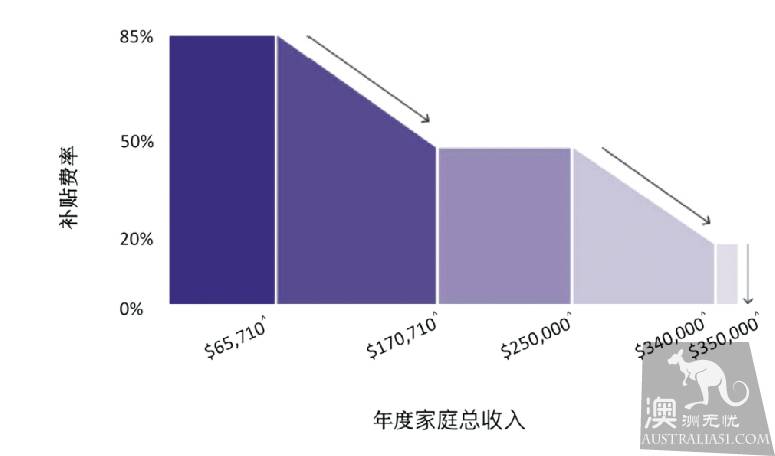
The cost subsidy for childcare services in Australia will change with effect from July 2, 2018. Child Care Rebate (childcare fee (refunds) and Child Care Benefit (childcare benefits (will be replaced by a single Child Care Subsidy (childcare subsidy). Goverment has committed an additional $2.5 billion to support the implementation of New Child Care Package.
The 2014 Survey of Child Care and early Education by the Productivity Commission and a series of subsequent consultations have found that the current system of childcare services is complex and difficult for families to use. And child care is inflexible in meeting family needs. Goverment responded by announcing a package of reforms to help families meet their work needs and provide more targeted support services to vulnerable families and children.

The following is the main overview of New Child Care Package:
As of 2 July 2018, as part of this package, Child Care Rebate and Child CareBenefit will be replaced by a single Child Care Subsidy; the level of Child Care Subsidy in the family will depend on three factors:
- Unified household income
- Level of activity of two parents (whichever parent has the lowest number of recognized activities)
- Type of childcare service used by the family
Under the new arrangement, most families will enjoy cheaper childcare services. Most low-and middle-income families will be eligible for higher child-care subsidies than they are now. For families with an income of $185710 or less, there will be no upper limit on the amount of Child Care Subsidy that can be claimed. For families earning more than $185710 but less than $350000, the current annual ceiling will increase from $7613 per child to $10000 a year. In other words, the lower the income of the communists, the more support families will receive;
The number of hours of subsidized child care available to families will be determined by the evaluation of activities. The higher the level of activity, the more subsidized childcare hours are available to families, up to 100 hours every two weeks. In families with two parents, the hours of subsidized childcare will depend on the parents who have the lowest number of hours of activity every two weeks. In addition, parents who are unable to meet the Activity Test (activity assessment) requirements but have reasonable reasons will be exempted.
Activities that can be recognized include:
- Paid work, including holidays such as maternity leave
- Approved study or training
- Unpaid work in family businesses
- job-hunting
- Voluntary work
- Self-employment
- Other activities assessed on a case-by-case basis
The new subsidy will also depend on the type of childcare service used by the family, but there is an upper limit on the hourly rate: Centre-based Care (Central Child Care), $11.55 per hou
Families should begin to consider how these reforms will affect themselves.
Zhang's Family case study
Zhang and Zhang Wei emigrated from Shanghai, China, to Australia in 2007, where they lived happily and reunited with other families who had emigrated to Australia around the same time. The Zhang couple have two children, 7-year-old super-super and 3-year-old Lili. Zhang Na and Zhang Wei both work full-time, and their combined family income is 158535 yuan a year.
Zhang Na's profession is a medical worker, while Zhang Wei's profession is an electrical engineer. They live a very busy life, both to cope with work and to take care of their children.
Couples can work full-time
From Monday to Thursday, the Zhang couple sent Super to the extra-curricular childcare service (Out of School Hours Care). This is provided by Super's local primary school, which he attended in the morning and afternoon. They thought it was good for his son, not only to keep him on a regular schedule, but also to socialize with other children of his age.
They sent their little girl Lili all week to (Long Day Care)., a long day care center near the local primary school. The daughter seemed happy there, and they noticed a cognitive development since she went to the center.
They felt it would be great for parents to use childcare and allow both of them to work full-time and pick up their children at 6 o'clock in the evening. They knew that their children would be taken good care of in a familiar and friendly environment.
The average fee for extra-curricular childcare services from Monday to Thursday is $26 in the morning and $39 in the afternoon, with an average fee of $13 per hour. They charge $140 a week for long day care from Monday to Friday for 10 hours a day and $14 per hour.
How do I calculate the amount of subsidy?
The subsidies to which they are eligible under the new childcare service programme (New Child CarePackage), will be calculated using three main elements: the annual income of the combined family; and the level of activity of the parents, including work, education and training; And the type of childcare service used.
Since the Zhang couple paid 13 yuan per hour for extra-curricular childcare services, which exceeded the maximum hourly rate limit (10.10 yuan), their allowance level was subject to the allowable ceiling of 10.10 yuan per hour. They pay 14 yuan per hour for long day care, which also exceeds the maximum hourly rate limit (11.55 yuan), so their allowance is subject to the maximum allowable rate of 11.55 yuan per hour.
According to the Zhang couple's annual income of 158535 yuan, they are eligible for extra-curricular childcare services and family day-care (FamilyDay Care) subsidies of 54% of 10.10 yuan per hour and 11.55 yuan per hour, respectively. The two ratios are forecast only. Under the current goverment aid program, the Zhang couple are eligible for a subsidy of 570 yuan a fortnight for their child care costs. With the launch of the new childcare service on July 2, 2018, the Zhang couple estimated that the assistance available would increase by 270 yuan, or 840 yuan every two weeks.
(this article is provided by Cultural Partners)

